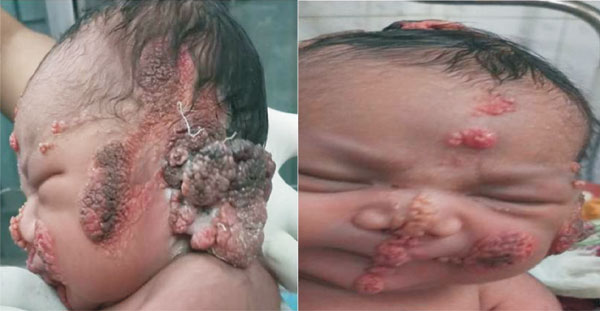|
|
|
Indian Pediatr 2018;55:1014 |
 |
Schimmelpenning Syndrome
|
|
Sameer Sarswat1
and Niharika Dixit2
From Departments of 1Pediatrics, and
2Dermatology, Venereology and Leprosy, Dr RML Hospital and PGIMER,
New Delhi, India.
Email:
drniharikadixit@gmail.com
|
|
A full-term newborn delivered vaginally with birth
weight of 3240 g presented to us with linear verrucous plaques involving
face, scalp, upper back and upper limbs. Few plaques were erythematous
to skin-colored while some were hyperpigmented (Fig. 1).
Whole left ear was covered with plaques. Histopathological examination
showed hyperkeratosis, focal parakeratosis, follicular plugging,
irregular acanthosis, papillomatosis and focal fusion of rete ridges.
The patient was diagnosed as Schimmelpenning syndrome. Echocardiography
revealed patent ductus arteriorus (PDA) for which the patient was
reffered to Pediatric Cardiology services.
 |
|
Fig. 1 Erythematous skin-coloured
linear verrucous plaques present over face, scalp and ear.
|
Schimmelpenning syndrome (SS) is a congenital
neurocutaneous disorder encompassing the cutaneous nevi (nevus sebaceous
of Jadassohn) in conjunction with extracutaneous (neurologic, skeletal,
cardiovascular, ophthalmic, and urologic) anomalies. It is a type of
epidermal nevus syndrome with nevus sebaceous in blashkoid distribution
as the hallmark lesion and cerebral abnormalities as the most common
systemic findings (66%). Vascular anomalies are found in 12.6 to 33% of
patients with SS. Nevus syringocystadenomatosus papilliferus, which is a
sweat gland adenoma, can be differentiated from SS as lesions are pink
and nodular. Surgical excision of nevus is the mainstay of treatment.
|
|
|
 |
|

